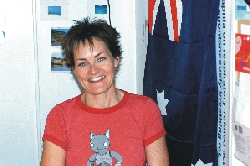Our faculty are internationally recognized scientists who use innovative techniques and experimental approaches from molecular to human studies, with expertise in professional development and have received nationally recognized mentoring awards. Our valued faculty members are listed under three categories:
Training Faculty - Active researchers who are able to supervise dissertations and theses.
Affiliated Faculty - Active in teaching and may serve on dissertation and thesis committees.
Emeritus Faculty - Continuing professionals who retired in good standing after 15 years or more, and who have been awarded Emeritus status by the President of the University of Arizona.

Program Affiliations: Psychology, Bio5 Institute, Physiological Sciences
Website and Publications:
Contact Information: (520) 626 1704, gene.alexander@arizona.edu
Research Interests: Neuroscience/Aging: brain-behavior relationships in the context of aging and age-related, neurodegenerative disease
- My research and academic interests focus on the study of brain-behavior relationships in the context of aging and age-related, neurodegenerative disease. I use neuroimaging techniques, including structural and functional magnetic resonance imaging (MRI) and positron emission tomography (PET), in combination with measures of cognition and behavior to address research questions on the effects of healthy aging and Alzheimer’s disease on the brain and on the mechanisms of human cognitive aging. A major focus of my research program includes the use of univariate and multivariate network analysis techniques with multiple neuroimaging methods and measures of neuropsychological function, health status, and genetic risk to understand how these factors interact to influence cognitive function as we age. My research also includes the application of these techniques to non-human animal models of aging and age-related disease. I direct the Brain Imaging, Behavior & Aging Lab in the Department of Psychology, have an appointment in the Evelyn F. McKnight Brain Institute, and direct the MRI Morphology Core of the Arizona Alzheimer’s Research Center.

Program Affiliations: Animal Sciences, Nutritional Sciences, Physiological Sciences
Website and Publications:
Contact Information: (520) 626-1754, rallen@ag.arizona.edu
Research Interests: Muscle Biology, Animal Sciences, Skeletal Muscle
-
The focal point of research in this laboratory is the growth and repair of skeletal muscle in domestic animals and humans. The key player in both of these processes is the satellite cell. Satellite cells are muscle stem cells that are generally found in a quiescent, or dormant, state in close association with muscle fibers. Although sparsely distributed in postnatal muscle, they play an important role in regulating muscle growth by dividing and fusing with existing muscle fibers. The result is a net increase in the number of muscle fiber nuclei and hence, an increase in the growth potential of the fiber. In injured muscle, satellite cells are stimulated to divide and form new fibers that replace damaged muscle fibers. Consequently, the rate and efficiency of muscle growth and repair are dependent on the activity of satellite cells, and therefore, satellite cell function is relevant to muscle growth in domestic animals, to human muscle disease and injury and to problems associated with aging
-
Research goals in this laboratory have been to identify the hormones and growth factors responsible for satellite cells activation from the quiescent state, division and fiber formation. This problem is being approached by integrating experiments at the cellular, tissue, and whole animal level.

Program Affiliations: Cell Biology and Anatomy, Cellular and Molecular Medicine, Bio5 Institute, Physiological Sciences
Website and Publications:
Contact Information: (520) 621-7201, pba@email.arizona.edu
Research Interests: Cardiovascular Disease: Embryogenesis, Tyrosine Kinases, Hepatocytes
- Research in our laboratory is focused on understanding the molecular regulation of early developmental processes in vertebrate embryos. We primarily use the chicken embryo as a model organism, and approach research questions from the dual perspective of how individual molecules function and how their functions can be integrated into network models. One present research emphasis is concerned with understanding epithelial to mesenchymal transition (EMT) during avian gastrulation. Microarray studies have shown that more than 1800 genes are upregulated in the epiblast adjacent to the primitive streak. Many of these genes are regulated by FGF signaling, including members of several other signaling pathways and at least thirty differentially expressed transcription factors. Fgf signaling therefore appears to be a key upstream regulator of EMT. Studies are investigating the intracellular signaling pathways downstream of Fgf receptor activation, including the MAPK, PI3K and AKT pathways. The MAPK pathway in particular directly regulates downstream gene transcription via activation of several transcription factors, including members of the Ets and T Box families. Studies are investigating downstream transcriptional targets of these factors.
- Another long standing research interest in the lab is the mechanisms controlling early stages of cardiac myogenesis, from the emergence of premyocardial cells during gastrulation to formation of the primitive heart tube. Bmp and Fgf signaling are well known activators of genes in the cardiogenic pathway, however relatively few direct transcriptional targets of these signaling pathways have been identified. By combining classical experimental embryological approaches with genome wide microarray analyses, we are working to generate a large-scale model of cardiac myogenesis.
- These studies are integrating with a parallel effort to generate broad approaches for developing network models of biological processes in vertebrates. This involves high throughput in situ hybridization and microarray gene expression analysis and large scale-collation of published information to generate preliminary network models. Models are then tested through parameter space using software tools such as Ingeneue. Results are integrated with an artificial intelligence software environment that evaluates results and can suggest network modifications for retesting. Promising candidate network models are then tested in vivo. Through successive reiterations between computational network modeling and model testing in vivo, progressively more representative networks can be generated. Initial efforts are focused on modeling EMT during gastrulation and cardiac myogenesis.
- Our laboratory also hosts the GEISHA in situ hybridization database and website (http://geisha.arizona.edu (link is external)). The GEISHA project (gallus expression in situ hybridization analysis) began in 1998 to investigate using high throughput whole mount in situ hybridization to identify novel, differentially expressed genes in chicken embryos. An initial expression screen of approximately 900 genes demonstrated feasibility of the approach, and also highlighted the need for a centralized repository of in situ hybridization expression data. Funding was eventually obtained for this purpose. The goals of the GEISHA project are to obtain whole mount in situ hybridization expression information for all differentially expressed genes in the chicken embryo between HH stages 1-25, to integrate expression data with the chicken genome browsers, and to offer this information through a user-friendly graphical user interface

Program Affiliations: Bio5 Institute, Physiology, Physiological Sciences
Website and Publications: Bailey Lab Homepage
Contact Information: (520) 626-8299, ebailey@u.arizona.edu
Research Interests: Neuroscience: Sleep apnea, Cranial, Motoneuron, Respiration, Sleep, Menopause
- My research focus is the neural control of breathing in human and nonhuman mammals. My earlier work assessed the role of pulmonary stretch receptors and central chemoreceptors in the genesis and relief of dyspnea or shortness of breath in healthy adults. These studies led to studies in the mammalian (rodent) airway that explored the modulation of upper airway muscles activities by chemical and pulmonary afferent feedback and the potential for selective electrical stimulation of the cranial nerve XII to alter airway geometry and volume (NIH/NIDCD RO3). Beginning in 2005, with the support of an NIH/NIDCD K23 I began work in neural control of upper airway muscles using tungsten microelectrodes to record from single motor units in adult human subjects. This work led in turn, to studies of regional (or segmental) muscle and motor unit activities in human subjects under volitional, state-dependent (i.e., wake/sleep) and chemoreceptor drives, in health and disease (NIH/NIDCD RO1). On the basis of the experimental work in muscle and motor units I have pursued additional lines of enquiry focused on clinical respiratory dysfunction in two specific populations a) infants at risk for SIDS and b) adults diagnosed with obstructive sleep apnea (OSA). Both lines of enquiry are highly innovative and have diagnostic and clinical applications. One recent line of enquiry explores the potential for a non-pharmacologic intervention daily to lower blood pressure and to improve sleep in patients diagnosed with mild-moderate obstructive sleep apnea. This training protocol shows promise as a cheap, effective and safe means of lowering blood pressure and improving autonomic-cardiovascular dysfunction in patients who are unwilling or unable to use the standard CPAP therapy.
Image
Program Affiliations: Neuroscience GIDP, Physiology, Physiological Sciences
Website and Publications: Bao Lab Homepage
Contact Information: (520) 621-5680, sbao@email.arizona.edu
Research Interests: Neuroscience: Auditory Perception and Learning
-
Perception is shaped by early experience. For example, exposure to native speech sounds improves our sensitivity to native speech contrasts, but can also reduce our sensitivity to foreign speech contrasts. How does experience alter neural circuits? How do the changes in neural circuits influence our perception? We address these questions in rodent models using a combination of electrophysiological, behavioral, and computational approaches.
-
In certain neurological disorders, learning mechanisms are either impaired or operate under abnormal conditions. For example, while early acoustic exposure alters the auditory brain circuits in normal mice, such experience-dependent brain changes are absent in a mouse model of fragile X syndrome. Another example is homeostatic plasticity, which, under normal physiological conditions, keeps the neuronal firing rate in a range to optimally encode information. However, under the pathological condition of hearing loss, homeostatic plasticity may operate erroneously and cause tinnitus and hyperacusis. What are the cellular and molecular mechanisms underlying these brain disorders? Can we target those mechanisms for treatment of the disorders? We investigate these questions using a multifaceted approach that includes molecular biology, biochemistry, intracellular electrophysiology, ontogenetics, and behavioral techniques.

Program Affiliations: Bio5 Institute, Psychology, Physiological Sciences
Website and Publications: Psychology Faculty Homepage
Contact Information: (520) 626-2616, carol@nsma.arizona.edu
Research Interests: Neuroscience: Delineation of brain changes during late ontogeny and functional consequences on information processing
-
Dr. Barnes' research interests involve the delineation of brain changes during late ontogeny (senescence) and the functional consequences of these changes on information processing and memory in older organisms. The major emphasis of the research in her lab has been an examination of the relationship between neurological change in the hippocampal formation of old rats and the accompanying decline of spatial learning-memory performance.
-
The methods used include extra- and intracellular stimulation and recording in the in vitro hippocampal slice preparation and extracellular techniques in both the acute (anesthetized) and chronically prepared (unrestrained) animal. Some recent experiments have also been conducted using the new multiple single cell recording system developed here at the ARL Division of Neural Systems, Memory and Aging. Behavioral tests of spatial perception and memory (known to require an intact hippocampus for their proper performance) are routinely used in conjunction with the neurophysiological experiments, in order to most effectively assess brain-behavior relationships.
-
The long-term goal of this work is a more complete understanding of the biological basis for the deterioration of cognitive function known to occur in the elderly. Such an understanding will hopefully lead to the development of neuropharmacological manipulations which much alleviate or delay neurophysiological and neuroanatomical changes known to occur normally with age, and which are responsible for the observed cognitive defects.

Program Affiliations: Animal Sciences, Physiological Sciences
Website and Publications:
Contact Information: (520) 621-9435, boganr@email.arizona.edu
Research Interests: Reproductive Physiology, Animal Sciences
- In his position at the University of Arizona Dr. Bogan will be researching reproductive physiology with an emphasis on ovarian biology. Once his research lab has been launched Bogan will begin teaching several classes in reproduction with the exact topics to be determined.

Program Affiliations: Physiology, Cell Biology & Anatomy, Immunobiology, Bio5 Institute, Physiological Sciences
Website and Publications:
Contact Information: (520) 626-2105, sboitano@email.arizona.edu
Research Interests: Asthma, Respiratory Physiology, Lung Epithelia
- We use unique primary tissue culture models of lung epithelial cells to study the cellular and tissue function of the lung epithelium. The conducting airway epithelium is an active cellular layer made up of a variety of cell types that is typified by ciliated airway epithelial cells that contribute to mucociliary clearance. The epithelial layer that lines the alveoli of the distal mammalian lung is made up of two distinct cell types, alveolar type I (AT1) and alveolar type II (AT2) cells. Physiological functions of AT1 cells include the primary site of gas exchange and of AT2 cells include the production of critical secretions that keep the lung from collapsing. Just as importantly, AT2 cells serve as "stem cells" that divide, migrate and differentiate to reform the AT1/AT2 epithelial layer following insult or injury. Also important to studies in our laboratory, lung epithelial cells provide innate immune function via a variety of events. These events include: the establishment of an epithelial "barrier;" the secretion of anti-microbial and inflammatory effector molecules; and direct interaction with non-epithelial cells (e.g. alveolar macrophages) to further immune function.
- Our current studies include four foci: 1) Host/Pathogen Interactions in the Airway; 2) Intercellular Communication in the Airway Epithelium; 3) Arsenic Effects on Airway Epithelial Signaling and Physiology; and 4) Re-establishment of a Functional Airway Epithelium following insult or injury. In the host/pathogen interaction studies, we are using a ciliated cell culture model to better understand early events in airway infection by primary colonizing bacteria from the Bordetellae. This includes elucidation of bacteria and host proteins that contribute to ciliary binding and the innate host defenses activated by this early host/pathogen interaction. In the intercellular communication studies we are elucidating the molecular mechanisms that allow for second messenger signaling within and between airway epithelial cells in the conducting airway and in the alveoli. In the arsenic studies we are evaluating the effects of environmentally significant amounts of arsenic on airway epithelial physiology. In the epithelial repair foci, we are studying the contributions of extracellular matrix molecules and neighboring cells to the re-establishment of a functional airway epithelium following large-scale wounding or local disruption by toxicants and/or toxins.

Program Affiliations: Physiology, Bio5 Institute, Physiological Sciences
Website and Publications:
Contact Information: (520) 626- 7134, ejbraun@u.arizona.edu
Research Interests: Comparative Renal Physiology
- Comparative renal physiology and morphology; regulation of individual nephron filtration rates and renal blood flow.

Program Affiliations: Physiology, Sarver Heart Center, Physiological Sciences
Website and Publications: Sarver Heart Center Profile
Contact Information: (520) 621-5485, zcohen@email.arizona.edu
Research Interests: Platelets, Immunobiology

Program Affiliations: Animal and Biomedical Sciences, Physiological Sciences
Website and Publications:
Contact Information: (520) 621-7622, rcollier@ag.arizona.edu
Research Interests: Environmental Physiology
- The focus of this laboratory is in studying environmental effects on gene expression in domestic animals. Research program utilizes both practical management models as well as controlled environmental facilities to modify environments around animals. Environmental effects on gene expression are then evaluated using gene expression microarrays, real time PCR and northern blots. Domestic animals of interest include dairy and beef cattle, horses, sheep and goats.

Program Affiliations: Arizona Biological and Biomedical Sciences, Biomedical Engineering, Biochemistry and Cellular & Molecular Biology, Physiological Sciences
Website and Publications: NCBI MyBibliography, The Colson Laboratory, Sarver Heart Center Profile,
Contact Information: (520) 621-1950, bcolson@email.arizona.edu
Research Interests: Cardiovascular Physiology: Deciphering the structural basis for cardiac muscle contraction and genetic heart disease at the molecular level
-
Dr. Colson’s research interests include understanding the molecular motions of muscle proteins that finely-tune and regulate the heart’s contractile performance.
-
The primary goal of his current research is to understand the relationship between the structural, biochemical, and physiological states in the mechanisms underlying cardiovascular dysfunction in genetic heart disease. These insights from the mechanistic studies in his lab are then used to design novel molecular therapies for heart failure and cardiovascular disease.
-
Recent work in the Colson lab has focused on how genetic mutations and changes in post-translational modifications in myosin binding protein-C can cause the development of hypertrophic cardiomyopathy, the most common cause of sudden cardiac death in young people.
-
Using site-directed spectroscopy, with high resolution in both space and time, Dr. Colson and his research team decipher the molecular dynamics in these muscle proteins, which are involved with controlling the strength and speed of cardiac muscle contraction. For these biophysical experiments, they attach fluorescent probes to track protein motions, orientation, and functional characteristics including protein binding and force development in the muscle cell. Similar state-of-the-art approaches are also used in his lab’s efforts for drug and small molecule discovery as novel heart failure therapies.

Program Affiliations: Psychology, Physiological Sciences
Website and Publications: Psychology Faculty Homepage
Contact Information: (520) 626-2615, scowen@email.arizona.edu
Research Interests: Neuroscience: Psychology

Program Affiliations: Animal and Biomedical Sciences, Bio5 Institute, Southwest Environmental Health Sciences Center, Arizona Cancer Center, Physiological Sciences
Website and Publications: ACBS Faculty Homepage, NCBI MyBibliography
Contact Information: (520) 621-9965, zr.craig@arizona.edu
Research Interests: Reproduction and infertility in animals and humans
- Dr. Craig's work focuses on understanding how phthalates affect the function of the ovary, the major reproductive organ in females. Thus, work in her laboratory is focused on using animal models to help us understand the mechanisms by which phthalates exert their effects on the ovary, determine whether phthalates cause female infertility, and examine whether the effects of phthalates on female reproduction can be prevented or reversed. Using this knowledge she hopes to develop additional models to evaluate other chemicals and environmental factors that could influence both human and animal reproduction.

Program Affiliations: Physiology, Bio5 Institute, Physiological Sciences
Website and Publications:
Contact Information: (520) 626-7646, dantzler@u.arizona.edu
Research Interests: Renal Physiology, Cation and Anion Transport
-
Relationship of structural organization of thin limbs of Henle's loops to function in mammalian renal inner medulla.
-
Recycling of amino acids and organic osmolytes between Henle's loops and vasa recta in mammalian renal inner medulla.
-
Regulation of intracellular pH in thin limbs of Henle's loops in mammalian renal inner medulla.
-
Cellular and molecular mechanisms and regulation of organic anion and cation transport in renal proximal tubules of mammals, birds, and reptiles.

Program Affiliations: Medical Pharmacology, Neuroscience, Bio5 Institute, Physiological Sciences
Website and Publications:
Contact Information: (520) 626-7643, davistp@U.arizona.edu
Research Interests: Stroke, Drug Transport, Blood-Brain Barrier
- Our laboratory continues its long-term CNS biodistribution research program, funded by NIH since 1981, by studying the mechanisms involved in delivering drugs across the blood-brain barrier to the C.N.S. during pathological disease states. We have recently discovered specific drug transporters which can be targeted to enhance delivery. We are also interested in studying the effect of hypoxia/aglycemia/inflammatory painon endothelial cell permeability and structure at the blood-brain barrier. We have recently shown that short-term hypoxia/aglycemia leads to significant alterations in permeability which can be reversed by specific calcium channel antagonists. This work has significant consequences to the study of stroke. Additionally, we have recently shown that peripheral pain has significant effects on BBB tight junction protein cytoarchitecture leading to variations in the delivery of analgesics to the CNS.

Program Affiliations: Physiology, Bio5 Institute, Physiological Sciences
Website and Publications: NCBI MyBibliography
Contact Information: (520) 626-6425, delamere@arizona.edu
Research Interests: Glaucoma, Na,K-ATPase
- Na,K-ATPase regulation
- Aqueous humor secretion
- Na,K-ATPase-Src kinase interaction in lens epithelium
- Role of Na,K-ATPase alpha 2 in astrocytes

Program Affiliations: Department of Medicine, Department of Cellular and Molecular Medicine, Physiological Sciences
Website and Publications: Laboratory of Ankit Desai, NCBI MyBibliography
Contact Information: (520) 626-6867, adesai@shc.arizona.edu
Research Interests: Understanding post-translational mechanisms of pulmonary vascular disease involving ubiquitination and glycosylation
- The Desai lab focuses on two projects both converging on investigating post-translational mechanisms of pulmonary vascular disease. Project one goals will dissect the role of candidate genes within the ubiquitination pathway; project two will characterize the role of o-glycosylation and relevant candidate genes in the development of pulmonary vascular disease. The lab leverages genome-wide studies (GWAS and expression profiling) in patients with pulmonary hypertension (PH) to prioritize and functionally elucidate target genes and variants in vitro and in vivo. The lab utilizes cell culture work with pulmonary artery endothelial and smooth muscle cells from healthy controls and patients with PH as well as murine and rodent animal models of PH. Base don these mechanisms, we are testing novel pharmacological and molecular therapeutics in PH animal models.

Program Affiliations: Physiology, Biomedical Engineering, Neuroscience, Bio5 Institute, Physiological Sciences
Website and Publications: Eggers Laboratory, NCBI MyBibliography
Contact Information: (520) 626-7137, eeggers@u.arizona.edu
Research Interests: Diabetic Retinopathy, Neurophysiology, Visual Physiology, Inhibition
-
The broad goal of research in our laboratory is to understand how inhibitory inputs influence neuronal signaling and sensory signal processing in the healthy and diabetic retina. Neurons in the brain receive inputs that are both excitatory, increasing neural activity, and inhibitory, decreasing neural activity. Inhibitory and excitatory inputs to neurons must be properly balanced and timed for correct neural signaling to occur.
-
To study sensory inhibition we use the retina, a unique preparation which can be removed intact and can be activated physiologically, with light, in vitro. Thus using the retina as a model system, we can study how inhibitory synaptic physiology influences inhibition in visual processing. This intact system also allows us to determine the mechanisms of retinal damage in early diabetes.

Program Affiliations: Neurology, Pharmacology, Physiological Sciences
Website and Publications: Neurology Faculty Homepage, NCBI MyBibliography
Contact Information: (520) 626-3927, tfalk@u.arizona.edu
Research Interests: Neuroscience: Parkinsons

Program Affiliations: Psychology, Physiological Sciences
Website and Publications: Psychology Faculty Homepage, Fellous Homepage
Contact Information: (520) 621-7447, fellous@email.arizona.edu
Research Interests: The processes involved in learning and memory consolidation depend on sleep and emotions, the neural substrates of PTSD and the neural substrate of empathy
- My research and academic interests focus on the study of brain-behavior relationships in the Computational Neuroscience. Neural substrate of emotion, learning and memory in rats and humans, PTSD, empathy.

Program Affiliations: Physiology, Neuroscience, Bio5 Institute, Physiological Sciences
Website and Publications:
Contact Information: (520) 621-2203, fregosi@u.arizona.edu
Research Interests: Neuroscience: Sleep Apnea, Neurophysiology, Regulation of Breathing
- We are interested in the development of inhibitory and excitatory synaptic transmission in brainstem respiratory neurons, and how normal development is disrupted by in utero nicotine exposure. We use hypoglossal motoneurons and preBotzinger complex inspiratory neurons as our model. Studies are done using neonatal rat or mouse brainstem slices that retain rhythmic respiratory-related motor output in vitro. We also use the in vitro brain stem spinal cord preparation of neonatal rats and mice, and conduct parallel in vivo studies of breathing behavior in awake neonatal rodents.Techniques include whole cell patch clamp electrophysiology (both voltage and current clamp), extracellular recording, immunohistochemistry, Western blot analysis, and in vivo measures of neonatal breathing using plethysmography.

Program Affiliations: Surgery, Physiological Sciences
Website and Publications:
Contact Information: (520) 626-0478, rfriese@surgery.arizona.edu
Research Interests: Surgery

Program Affiliations: Physiology, Neuroscience, Biomedical Engineering, Bio5 Institute, Physiological Sciences
Website and Publications: Fuglevand Lab
Contact Information: (520) 621-6983, fuglevan@u.arizona.edu
Research Interests: Neuroscience: Neurophysiology, Motor Control, Motor Neurons, Skeletal Muscles
- The broad goal of the work carried out in our laboratory is to understand how the mammalian nervous system controls the action of skeletal muscles to produce coordinated movements. We use a variety of experimental approaches, including computer modeling and simulation, single motor unit recording, and microneurographic methods to record and stimulate single sensory and motor axons. Our experiments address a range of topics from those related to how individual neurons integrate synaptic information to those associated with the development of new methods to restore movement and sensation in paralyzed individuals. Of particular emphasis at present are studies designed to characterize the functional organization of the corticospinal pathways that underlie the control of hand and finger movements.

Program Affiliations: Department of Medicine, Bio5 Institute, Arizona Cancer Center, Sarver Heart Center, Physiological Sciences
Website and Publications: Cancer Center Profile
Contact Information: (520) 626-3242, jfunk@u.arizona.edu
Research Interests: Osteoporosis, Arthritis, Cardiovascular, Botanicals
-
Current Research projects include:
-
Exploring the efficacy and mechanism of action of medicinal botanicals in the treatment of common bone disorders, including osteoporosis and arthritis.
-
Targeting PTHrP for breast cancer bone metastases prevention.
-
Use of botanical dietary supplements as anti-inflammatory agents in the treatment of cardiovascular disease and diabetes.

Program Affiliations: Nutritional Sciences, Bio5 Institute, Physiological Sciences
Website and Publications:
Contact Information: (520) 621-4705, going@u.arizona.edu
Research Interests: Diabetes/Obesity: Body Composition, Growth and Aging
-
Current projects include:
-
The Bone, Estrogen and Strength Training (BEST) study, a randomized prospective study of the effects of hormone replacement therapy on bone mineral density, soft tissue composition, and muscle strength in postmenopausal women (National Institutes of Health).
-
The Profile-based Internet-linked Obesity Treatment study (PILOT), a randomized study of internet support for weight maintenance after weight loss in peri-menopausal women (National Institutes of Health).
-
The Trial of Activity for Adolescent Girls (TAAG) study, a multi-center, school-based activity trial designed to prevent the usual decline in physical activity in adolescent girls (National Institutes of Health).
-
The Adequate Calcium Today (ACT) study, a randomized multi-center study of a behavioral intervention to promote healthy eating, calcium intake and bone development in adolescent girls (United States Department of Agriculture).
-
The Healthy Weight in Adolescents study, a randomized, multi-center study of the effects of a science-based curriculum focused on concepts of energy balance on body weight and composition in adolescent boys and girls (United States Department of Agriculture).
-
The KNEE study, a randomized clinical trial of the effects of resistance exercise on disease progression, pain, and functional capacity in osteoarthritis patients (National Institutes of Health).
-
The STRONG study, a randomized clinical trial of the effects of resistance exercise and Remicaid on disease progression, pain, muscle strength and functional capacity in rheumatoid arthritis patients (Centocor, Inc.).
-
Partners for Healthy Active Children, Campañeros Para Niños Sano y Actives, designed to create and implement research-based physical education and nutrition curricula at YMCA after-school programs and Sunnyside District elementary schools, in alignment with the State of Arizona , Health and Physical Activity standards (Carol M. White Physical Education Program CFDA #84.215F).
-
Longitudinal Changes in Hip Geometry, an observational and experimental cohort study of changes in muscle mass, hip structural parameters and hip bone strength in middle-aged and older women in the Women's Healthy Initiative study (National Institutes of Health).
-

Program Affiliations: Physiology, Neuroscience, Bio5 Institute, Physiological Sciences
Website and Publications:
Contact Information: (520) 626-1448, kgothard@email.arizona.edu
Research Interests: Neuroscience: Emotion, Social Behavior
- The broad goal of the research in our laboratory is to understand the neural basis of emotion. We use non-human primates as a model system for normal and pathological emotions generated in the context of social behavior. The experiments involve eliciting emotions in freely behaving monkeys while recording neural activity from several brain areas in conjunction with cardiovascular and other autonomic measurements. These experiments reveal the real-time dynamic interaction of multiple systems implicated in emotion regulation and the mechanisms by which emotional responses produce immediate behavioral effects

Program Affiliations: Cellular and Molecular Biology, Physiology, Biomedical Engineering, Biological Physics, Physiological Sciences
Website and Publications: NCBI MyBibliography
Contact Information: (520) 626-3641, granzier@email.arizona.edu
Research Interests: Cardiovascular Disease: Muscle, Cardiac, Cells, Mechanics, Titin, Contractility
- Muscle structure and function

Program Affiliations: Cellular and Molecular Medicine, Physiological Sciences
Website and Publications: Department of Medicine Faculty Homepage
Contact Information: (520) 621-0291, samharris@email.arizona.edu
Research Interests: Cardiovascular Disease: Cellular and Molecular Medicine

Program Affiliations: Physiology, The McKnight Brain Institute, Sarver Heart Center, National Institute for Civil Discourse, Physiological Sciences
Website and Publications: Hay Laboratory
Contact Information: (520) 626-7384, mhay@arizona.edu
Research Interests: Neuroscience/Hypertension: neurotransmitter, peptide and cellular mechanisms in central brain
- The primary focus of our laboratory is the understanding of how the brain regulates blood pressure.
- We study the neurotransmitter, peptide and cellular mechanisms in central brain nuclei that regulate sympathetic outflow and ultimately arterial blood pressure.
-
Our ultimate goal is to identify potential new phamacotherapies that will improve the lives of individuals who suffer from cardiovascular disease.
Image
Program Affiliations: Physiology, Biochemistry and Molecular & Cellular Biology, Nutritional Sciences, Bio5 Institute, Physiological Sciences
Website and Publications: Sarver Heart Center Profile
Contact Information: (520) 621-4104, ejhenrik@u.arizona.edu
Research Interests: Diabetes: Regulation of Glucose Transport, Insulin
- Regulation of glucose transport in muscle by insulin and contractions
- Role of glycogen synthase kinase-3 in the etiology of skeletal muscle insulin resistance
- Role of oxidative stress in the development of defective insulin signaling and glucose
transport in skeletal muscle - Pharmaceutical and nutriceutical interventions for the treatment of insulin resistance of
skeletal muscle glucose transport - Adaptive responses of carbohydrate and protein metabolism in muscle to exercise,
simulated weightlessness, and denervation

Program Affiliations: Physiology, Pharmacology & Toxicology, Animal Sciences, Physiological Sciences
Website and Publications:
Contact Information: (520) 626-6688, hoyer@u.arizona.edu
Research Interests: Ovarian physiology/toxicology, menopause
- Elucidating signaling pathways that regulate cell death by apoptosis
- Establishing mechanisms of ovotoxicity caused by environmental chemicals
- Developing models that alter the rate of atresia in ovarian follicles
- Characterizing a chemically-induced follicle-depleted ovary-intact rodent for peri- and post- menopause

Program Affiliations: Surgery, Physiological Sciences
Website and Publications:
Contact Information: (520) 621-0120, zkhalpey@surgery.arizona.edu
Research Interests: Surgery

Program Affiliations: Pediatrics, Bio5 Institute, Physiological Sciences
Website and Publications: Pediatrics Faculty Page
Contact Information: (520) 626-9687, pkiela@peds.arizona.edu
Research Interests: Pediatrics
- Therapeutic and pathophysiological aspects of Inflammatory Bowel Diseases.Crohn's disease (CD) and ulcerative colitis (UC) are two spontaneously relapsing, immunologically mediated disorders of the gastrointestinal tract which are characterized by intestinal inflammation and mucosal damage. These chronic, debilitating conditions characterized by abnormal and persistent immune response to intestinal commensal flora have multifactorial etiology with genetic predispositions and environmental factors contributing to the ultimate clinical manifestation. Despite recent advances in understanding the pathophysiology of IBD and development of new biological agents to treat active inflammation and to maintain remission, our knowledge and therapeutic options are still limited.Our laboratory, funded by the National Institute of Diabetes and Digestive and Kidney Diseases of the NIH, studies three aspects of IBD:
- Pre-clinical studies on the effectiveness and mechanism of action of curcumin (a natural non-specific inhibitor of NF-kappa-B) in mouse models of CD and UC (chemically induced colitis and spontaneous colitis in IL-10 or TCR-alpha knockout mice).
- The role of NHE3. the major intestinal Na+/H+ exchanger in the maintenance of epithelial integrity of the gut. and in modulation of the immune response in Inflammatory Bowel Diseases.
- The effects of acute and chronic colitis and inflammatory mediators on key players of systemic inorganic phosphate homeostasis and its contribution to osteopenia and osteoporosis frequently associated with IBD.

Program Affiliations: Physiology, Bio5 Institute, Biomedical Engineering, Molecular Cardiovascular Research Program, Physiological Sciences
Website and Publications:
Contact Information: (520) 626-6578, konhilas@arizona.edu
Research Interests: Cardiovascular Disease: Heart Disease, Impact of Diet, Exercise, Sex
-
We are very interested in how the molecular and cellular biology of the heart cell impacts the contractile properties of the intact heart. We know that a number of factors influence gene expression and cell signaling in the cardiac myocyte including diet, exercise, disease and sex/gender. The changes induced by these factors will ultimately affect cardiac contractile function. It is this functional relationship that we are studying using a variety of molecular, cellular, and physiological techniques. We focus on the intermediates responsible for substrate utilization and presentation to the contractile apparatus. We hope to understand how the physiological factors of diet, exercise, disease and sex/gender impact substrates in the cell and how the presentation of these substrates affects contractile function. We believe that the interplay between contractile function and energy use is critical to health and disease.
-
We are also interested in how cardiac disease can influence peripheral organ systems including skeletal muscle. We know that humans with cardiac disease also experience severe skeletal muscle weakness and fatigue. This cannot be attributed entirely to poor circulation caused by reduced contractile function. Instead, we believe that is the specific alteration of specific muscle factors responsible for substrate metabolism and delivery to the muscle cell.

Program Affiliations: Arizona Cancer Center, Physiological Sciences
Website and Publications: Cancer Center Profile
Contact Information: (520) 626-3719, tlandowski@azcc.arizona.edu
Research Interests: Cancer: Therapeutic Development

Program Affiliations: Neuroscience, Bio5 Institute, Physiological Sciences
Website and Publications:
Contact Information: (520) 621-6654, rbl4@email.arizona.edu
Research Interests: Neuroscience: Neuromuscular Systems, Steroid Hormones, Electrophysiology
- People in the Levine laboratory share a common interest in the function and development of neuromuscular systems. Neuromuscular systems, including the motoneurons that control movement and the muscles that they innervate, are modified throughout life by many factors including hormones, learning, training, and aging. We are using the molecular and genetic power of Drosophila, and mammalian systems to explore the neural circuits that control movement and the mechanisms through which steroid hormones regulate their function and postembryonic modification. Using techniques such as intracellular and whole-cell patch recording, dye injection, confocal microscopy and cell culture we are describing the biophysical properties, dendritic anatomy, and synaptic connections of individual motoneurons. Recent experiments explore the role of calcium and potassium currents in determining the functional properties of identified motoneurons that participate in locomotor and respiratory behavior

Program Affiliations: Animal Sciences, Bio5 Institute, Physiological Sciences
Website and Publications: Sarver Heart Center Profile
Contact Information: (520) 6262-7623, limesand@ag.arizona.edu
Research Interests: Diabetes: Pancreas Formation and Function, Fetal Nutrition, Type 2 Diabetes
-
Some of the most debilitating diseases affecting public health and those that impose an extreme monetary impact on health care costs in the United States are metabolic diseases and endocrine disorders such as Type 2 Diabetes. The prevalence of these diseases in the USA has been growing faster than Mendelian inheritance rates suggesting that environmental cues are influencing the prevalence of adulthood metabolic disorders. Inappropriate fetal growth and development due to inadequate fetal nutrition has been associated with several adult onset diseases including diabetes (Barker Hypothesis). Pancreatic b-cells secrete the anabolic hormone, insulin, in response to nutrient changes during the second half of gestation, likely coordinating fetal growth rate with fetal nutrient supply, making the fetal b-cell a potential target for nutritional adaptation in utero.
-
To understand nutrient regulation of fetal pancreas development, I am studying how poor fetal nutrition reduces pancreas formation and function. Environmental stress during pregnancy in sheep causes placental insufficiency; thus, creating an inadequate fetal nutrient supply that leads to fetal growth restriction and impaired insulin secretion due to decreased b-cell number and function. Current research aims are designed to determine mechanism that reduced b-cell responsiveness in intrauterine growth restricted fetuses. The first aim is to determine stages of pancreatic development and endocrine cell replication in this large animal model to understand how b-cell numbers are reduced. In addition to a lower number of b-cells, their stimulus secretion coupling is impaired due to reduced insulin production. Therefore, the second aim is to determine deficits in insulin biosynthesis. If these inadequacies shown in the growth restricted fetus are not compensated for after birth, they might persist into adulthood and contribute to failure of insulin secretion to predispose offspring to Type 2 Diabetes.

Program Affiliations: Nutritional Sciences, Cancer Biology, Bio5 Institute, Physiological Sciences
Website and Publications:
Contact Information: (520) 626-4517, limesank@u.arizona.edu
Research Interests: Cancer: Apoptosis, Salivary Acinar Cells, Radiation, Signaling
-
Radiation therapy for head and neck cancer causes adverse secondary side effects in the normal salivary gland including xerostomia, oral mucositis, malnutrition, and increased oral infections. Although improvements have been made in targeting radiation treatment to the tumor, the salivary glands are often in close proximity to the treatment site. The significant destruction of the oral cavity following radiation therapy results in diminished quality of life and in some cases interruptions in cancer treatment schedules.
-
My research program has its foundation in radiation-induced salivary gland dysfunction; mechanisms of damage, clinical prevention measures, and restoration therapies. Evidence suggests that salivary acinar function is compromised due to apoptosis induced by these treatments and temporary suppression of apoptotic events in salivary glands would have significant benefits to oral health. We utilize a number of techniques in my laboratory including: genetically engineered mouse models, real-time RT/PCR, immunoblotting, immunohistochemistry, primary cultures, siRNA transfections, irradiation, and procedures to quantitate salivary gland physiology.

Program Affiliations: Physiology, Biomedical Engineering, Biomedical Imaging and Spectroscopy, Bio5 Institute, Physiological Sciences
Website and Publications: Lynch Lab
Contact Information: (520) 626-2472, rlynch@u.arizona.edu
Research Interests: Diabetes and Cancer: Second Messenger Signalling, Diabetes and its Complications
- Research in the Lynch lab primarily focuses on second messenger signaling in vascular smooth muscle cells and nutrient sensing hypothalamic neurons with emphasis on alterations in signaling that occur during development of diabetes. Alterations in Ca2+ homeostasis and contractility are observed in vascular cells in association with the elevated levels of glucose and insulin that occur during development of type II diabetes. To study these issues, cells isolated from transgenic animals in which specific genes for Ca2+ handling are ablated or over-expressed are utilized as model systems. Analysis of subcellular protein distributions and second messenger signaling is performed in our lab using state of the art image acquisition and analysis approaches which is our second area of expertise. Over the past decade, our lab has been involved in the development of unique microscopic imaging and spectroscopy approaches to study cell and tissue function. As part of this effort, we have developed, with collaborators, methods for targeting specific cell types in mice for in situ identification and rapid isolation. Using this approach, analysis of cell-type specific gene expression and function can be performed.

Program Affiliations: Neuroscience, Bio5 Institute, Arizona Cancer Center, Evelyn F McKnight Brain Institute, Molecular and Cellular Biology, Physiological Sciences
Website and Publications: Neurology Faculty Homepage, Madhavan Lab
Contact Information: (520) 626-2330, lmadhavan@email.arizona.edu
Research Interests: Neuroscience: Parkinsons, Stem Cell Biology and Regenerative Medicine
- Research in the Madhavan lab broadly centers on stem cells, and how they can be used as tools to understand and treat neurological diseases. Within this framework, the lab is currently focused on Parkinson's Disease (PD) with projects investigating (1) stem cells in the context of aging and the onset of PD associated neurodegeneration, (2) etiology of PD using induced pluripotent stem cells, and (3) the therapeutic potential of adult stem cells in preclinical models of PD.

Program Affiliations: Pharmacology, Bio5 Institute, Physiological Sciences
Website and Publications:
Contact Information: (520) 626-0742, pmantyh@email.arizona.edu
Research Interests: Neuroscience: Pharmacology/Pain Research
- Develop clinically relevant models of malignant and non-malignant skeletal pain
- Mechanism-based understanding of the factors driving skeletal pain
- Evaluation of the effects that therapies have on pain and disease progression
- Regulation of bone remodeling by nervous system
- Stem cells and bone health
Image
Program Affiliations: Physiology, Physiological Sciences
Website and Publications:
-
Pannabecker TL, Dantzler WH, Layton HE, Layton AT. 2008. Role of three
dimensional architecture in the urine concentrating mechanism of the rat renal
inner medulla. American Journal of Physiology Renal Physiology, 295:F1271-
F1285. -
Layton AT, Layton HE, Dantzler WH, Pannabecker TL. 2009. The mammalian
urine concentrating mechanism: Hypotheses and Uncertainties. Physiology, 24:
250-256. -
Pannabecker TL. 2012. Structure and Function of the Thin Limbs of the Loop of
Henle. Comprehensive Physiology. 2:2063–2086. -
Pannabecker TL. 2013. Comparative physiology and architecture associated with
the mammalian urine concentrating mechanism. American Journal of Physiology
Regulatory Integrative and Comparative Physiology, 304:R488-R503.
http://ajpregu.physiology.org/cgi/content/full/ajpregu.00456.2012?ijkey=KEkty6wXNBqis&keytype=ref&siteid=physiology”>text (link is external)
Contact Information: (520) 626-6481, pannabec@email.arizona.edu
Research Interests: Renal Physiology, Membrane Transport
- The goal of the research conducted in my laboratory is to better understand
kidney structure and function in health and disease. To achieve this goal we
currently focus both on identifying and characterizing transepithelial fluid and
solute transport pathways within renal tubules and on characterizing fluid and
solute flows that occur between nephron segments and blood vessels. This is
accomplished using isolated tubule perfusion techniques and by constructing
three-dimensional digital models of the renal medulla. The animal models used
in the lab include the common laboratory rat and the desert-dwelling kangaroo
rat. Information from these studies has contributed to development of new and
revealing mathematical models that attempt to better understand the urine
concentrating mechanism.

Program Affiliations: Surgery, Physiological Sciences
Website and Publications: Surgery Faculty Homepage
Contact Information: (520) 626-4494, kkpapas@surgery.arizona.edu
Research Interests: Diabetes: Organ Transplant, Hypoxia/Oxygenation, Surgery
- He has spent the past 21 years of his research career studying the properties of insulin-secreting tissue and their relationship to viability and function. He has worked on the development and validation of assays (especially ones based on mitochondrial function such as oxygen consumption rate) for the real-time, objective assessment of islet quality prior to transplantation. In particular the assay based on oxygen consumption rate has been recently validated based on its ability to predict diabetes reversal in mice and clinical human islet auto transplants in patients with chronic pancreatitis. He has used these assays along with engineering principles to optimize the islet transplantation process from pancreas procurement to islet infusion to the recipient. His group has also developed tools for the real time non-invasive assessment of pancreases and other organs during preservation, and is actively involved in research for improvements in organ preservation technology aiming at extending the allowable time window from procurement to transplantation and the utilization of organs from expanded criteria donors without compromising clinical outcomes. He has had continuous NIH funding for the past 7 years in the area of pancreas preservation and he has spearheaded the effort for the development of humidified oxygen gas perfusion (persufflation) of the pancreas using novel technology for portable in situ oxygen generation from water via electrochemistry. He is also actively collaborating with leaders in the liquid perfusion field on NIH sponsored projects aiming at improving oxygenation. His research in this area has the potential to have a profound impact on reducing overall costs, increasing availability, and improving short-and long-term outcomes in solid organ transplantation.

Program Affiliations: Department of Pathology, Neuroscience, Bio5 Institute, Physiological Sciences
Website and Publications:
Contact Information: (520) 626-6099, nrance@email.arizona.edu
Research Interests: Neuroscience: Neuroendocrine Regulation, Estrogen, Hypothalamus
-
My overall research objective is to characterize and understand the events that occur in the human central nervous system in response to menopause. An equally important goal is to contribute to our understanding of the neuroendocrine mechanisms that regulate reproduction. Although complex, the neural basis of reproductive function is amenable to experimentation because of the known feedback circuits. Control mechanisms can be studied at many different levels, ranging from plasma hormone levels, to gene expression in subsets of hypothalamic neurons.
-
Menopause provides a unique opportunity to correlate physiology and neuroanatomy in the human brain because ovarian and pituitary hormones change dramatically and consistently. In the last decade, our laboratory has made considerable progress in characterizing changes in neuronal morphology and neuropeptide gene expression in the hypothalamus of postmenopausal women. We have found a number of changes that correlate with the ovarian failure of menopause. Neurokinin B and substance P gene expression is markedly increased in the infundibular nucleus of postmenopausal women, along with hypertrophy of these neurons. In addition, the gene expression of a separate subpopulation of LHRH neurons is increased in the medial basal hypothalamus of postmenopausal women. In contrast, POMC gene expression in the infundibular nucleus is decreased.
-
These observations have provided the direction of our studies using animal models. For example, the rat was used to test the hypothesis that increased neurokinin B gene expression in the hypothalamus of postmenopausal women is secondary to gonadal failure. These studies showed that that long-term gonadectomy results in increased numbers of arcuate (infundibular) neurons expressing NKB gene transcripts in both males and females. We have also found that long-term orchidectomy results in significant dendritic growth in neuroendocrine neurons in the arcuate nucleus of adult male rats. These data suggested that the withdrawal of gonadal steroids ultimately results in a substantial remodeling of hypothalamic neuronal circuits. We have hypothesized that the hypertrophied NKB neurons participate in the hypothalamic control of LH secretion. Our recent studies using both pharmacological and physiological methods provide strong support for this hypothesis.
-
Because menopause affects a well-characterized system and has consistent and substantial changes in hormone levels, our research program has been able to correlate alterations in hormone secretion with structural and neurochemical changes in the human hypothalamus. Our ability to address basic biological questions in the human CNS is greatly enhanced by the use of animal models to test hypotheses arising from our observations of the human hypothalamus. Characterization of the hypothalamic changes accompanying menopause has the potential not only of shedding light on the regulation of gonadotropin secretion and hypothalamic aging in the human, but may also have practical implications for the health of postmenopausal women.
Image
Program Affiliations: Physiology, Bio5 Institute, Physiological Sciences
Website and Publications:
Contact Information: (520) 621-3104, crankin@u.arizona.edu
Research Interests: Physiology/Teaching Workshop

Program Affiliations: Animal Sciences, Physiological Sciences
Website and Publications: ACBS Faculty Homepage
Contact Information: (520) 626-5793, bjrenquist@email.arizona.edu
Research Interests: Neuroscience/Obesity: neuroendocrine control of food intake and energy expenditure, HPA and HPG axis function
-
Dr. Renquist’s research is performed in cell culture, mouse, and fish models to address 4 foci:
-
Understanding the causative role of hepatic lipid accumulation in the development of obesity associated pathophysiologies. Hepatic lipid accumulation is directly linked to the severity and incidence of both Type II diabetes mellitus and hypertension. Our research aims to understand the signaling mechanism that links hepatic lipid accumulation to these disease states.
-
The physiological control of feed intake during heat stress. Heat stress suppresses food intake. The Renquist lab is focused on the role of heat induced changes in blood flow and how these may manipulate phagic drive.
-
Development of a single dose injectable sterilant - This project designed to develop a single dose injectable sterilant, funded by a Michelson Grant in Reproductive Biology, is employing GnRH-toxin conjugates to ablate gonadotropes which produce hormones that stimulate both egg and sperm maturation. By preventing both egg and sperm maturation we will effectively sterilize the animals.
-
Predicting growth in aquaculturally important species by measuring the metabolic rate of embryonic aquatic organisms (tilapia, oysters, and shrimp). In fish metabolic rate is tightly coupled to essential functions for growth (e.g. protein and DNA synthesis). This project will employ an assay that measures metabolic rate of fish, previously designed for drug development by Dr. Renquist, to sort aquaculturally important species (tilapia and trout) by metabolic rate and monitor subsequent growth rate.
-

Program Affiliations: Pharmacology, Physiological Sciences
Website and Publications:
Contact Information: (520) 626-2173, pronald@email.arizona.edu
Research Interests: Neuroscience: Physiology/Pathology of the Blood-Brain Barrier; effect of pathophysiological insult on CNS drug delivery; intracellular signaling systems; nuclear receptor pathways.
- The blood-brain barrier (BBB) is the principal physical and biochemical barrier that separates the central nervous system (CNS) from the systemic circulation. To this end, the BBB highly restricts flux of circulating substances in an effort to tightly control the CNS microenvironment and maintain cerebral homeostasis. In addition, the BBB is the most significant obstacle to drug delivery to the brain. In fact, many existing drugs have limited or no efficacy in the treatment of neurological diseases primarily due to a limited ability to traverse the BBB and accumulate within the CNS. The BBB has evolved specific transport mechanisms that mediate blood-to-brain xenobiotic permeability (figure 1). Paracellular diffusion between adjacent endothelial cells is restricted by the presence of tight junctions. Tight junctions are an intricate combination of transmembrane and cytoplasmic proteins linked to an actin-based cytoskeleton, which allows the tight junction to form a seal while remaining capable of rapid modulation. Brain uptake of a solute by the paraceullar route generally indicates a perturbation of BBB integrity. In fact, some drugs (i.e., codeine) have been shown to accumulate in the brain via paracellular diffusion. Additionally, uptake into and extrusion from the brain of many therapeutic agents is governed by drug transport proteins. Specifically, endogenous BBB transporters that have been shown to be involved in determining the brain permeation of pharmacological agents include the ATP-binding cassette superfamily of efflux transporters (i.e., P-glycoprotein, Multidrug Resistance Proteins, Breast Cancer Resistance Protein) and Organic Anion Transporting Polypeptides, a group of bidirectional and sodium-independent solute carriers that transport amphipathic substrates (figure 2). Recent evidence has suggested that pathological insult can lead to dramatic changes in expression and/or activity of transport proteins at the BBB and, subsequently, cause significant alterations in CNS drug delivery.
- The objective of my research is to examine how disease conditions (i.e., pain/inflammation, cerebral ischemia, hypoxia) can affect the uptake and/or efflux of drugs at the BBB. The research involves molecular studies to identify and characterize intracellular signaling systems and nuclear receptor pathways that regulate drug transport mechanisms at the BBB during pathophysiological insult. Signaling pathways may represent cellular targets that can be utilized to optimize CNS drug delivery. We also perform in vivo functional studies to characterize how molecular changes may affect distribution of therapeutic agents in the brain. A thorough identification and characterization of such processes is critical to obtaining an understanding of how disease can affect drug uptake and/or distribution to the CNS. The results of our studies may explain why acute and/or chronic pathophysiological insult may induce clinically significant changes in CNS drug efficacy and development of unexpected drug toxicity. Furthermore, these studies may demonstrate how functional changes in drug transport mechanisms at the BBB may be exploited to effectively deliver novel therapeutic agents to the CNS.

Program Affiliations: Cellular & Molecular Medicine, Cellular Biology & Anatomy, Bio5 Institute, Physiological Sciences
Website and Publications:
Contact Information: (520) 626-2326, rrunyan@email.arizona.edu
Research Interests: TGF-Beta, Cardiovascular System
-
In the heart, cells that form the valves are induced to develop by interaction between endothelial cells and adjacent muscle. As a result, cardiac endothelial cells transform into mesenchyme and become the constituents of the valves and walls of the heart. This process is known as an epithelial-mesenchymal transition or EMT. The objective of my research program is to understand the molecular mechanisms that mediate cell transformation in the heart.
-
Using a tissue culture assay, we showed that cardiac endothelia would only transform after stimulation by adjacent muscle. My laboratory has continued to examine the events which take place during this epithelial-mesenchymal cell transformation. Our studies focus upon three basic questions. 1) What is the nature of the signal produced by the muscle? 2) How do the target cells recognize the signal? 3) What events occur in the target cells in response to the stimulus? Answers to these questions will identify potential causes of congenital heart defects.
-
Work in the laboratory initially focused on the observation that the growth factor, Transforming Growth Factor Beta, is a component of the transformation process. As this growth factor is actually a member of a family of related molecules, we used RNase protection assays to show that two isoforms, TGFß2 and TGFß3, were found in the heart. Experiments using antisense DNA oligonucleotides demonstrated that TGFß3 is the critical component. More recently, our work shows that both isoforms are used in complementary roles.
-
Experiments show that this EMT in the heart is blocked by loss of several different classes of TGF-ß receptors, including Alk2, Alk5, TGFß Type II, TGFß Type III and Endoglin. As seen with the two different TGFß isoforms, each receptor component appears to mediate play a distinct role in the EMT process. Other experiments in this laboratory showed that EMT is sensitive to inhibitors of several classes of kinases, Gi proteins, and the phosphoinositide pathway. These pathways are being explored by cloning and targeted degradation of mRNAs of various components in order to track signals from the cell surface to the nucleus.
-
Another approach to the problem is towards the identification of regulatory genes expressed in response to the cardiac signal. Our focus is the immediate early genes which are likely to be transcriptional regulators of other genes required for valve formation. Our most recent efforts have focused on the genes Slug (Snail2), Meox-1, Runx2 and Paraxis. All of these genes appear to be critical transcription factors for the process of cell transformation.
-
A related research program in the lab is focused upon examining the relationship between events which take place during early valve development and the apparent cardio-teratogenicity of the environmental contaminant Trichloroethylene (TCE). In association with members of the Southwestern Environmental Health Sciences Center and the Superfund Program here at Arizona, we are trying to identify genes that are altered in developing hearts by exposure to this chemical.

Program Affiliations: Physiology, Bio5 Institute, Physiological Sciences
Website and Publications: Physiology Faculty Homepage
Contact Information: (520) 626-4513, secomb@u.arizona.edu
Research Interests: Theoretical studies of the microcirculation
-
The microcirculation is a network of extremely small blood vessels that supplies oxygen and nutrients to all parts of our tissues. The focus of work in our research group is the use of mathematical and computational approaches to study blood flow and mass transport in the microcirculation. Working in collaboration with experimentalists, we aim to understand quantitatively the processes involved. The main areas of our work are:
-
Mechanics of blood flow in microvessels. We are examining the relationship between red blood cell mechanics and flow resistance in microvessels. Theoretical predictions agree well with observations in glass tubes, but resistance is higher living tissue. We have found that the major cause is the presence of a relatively thick macromolecular lining (endothelial surface layer) on the walls of microvessels.
-
Mass transport to tissue. We are simulating oxygen exchange between networks of microvessels and surrounding tissues in skeletal muscle and tumors. In skeletal muscle, we have shown how oxygen can be exchanged diffusively between arterioles and capillaries, and we are studying the determinants of maximal oxygen consumption. In tumors, we are studying the relationship between network structure and occurrence of local hypoxic (radiation-resistant) regions. Also, we are analyzing the delivery of chemotherapeutic drugs in tumor tissues.
-
Structural adaptation of microvascular networks. We are developing models for the stuctural responses of microvessels to functional demands. We have found that maintenance of a stable, functionally adequate distribution of vessel diameters can be achieved if each vessel responds to changes in wall shear stress, intravascular pressure and local metabolic conditions, and if mechanisms exist for information transfer upstream and downstream along flow pathways.
-
Regulation of blood flow: We are developing models for the active regulation of blood flow by changes in vascular tone, taking into account vascular responses to wall shear stress, pressure and local metabolic state, and including effects of conducted responses along vessel walls.

Program Affiliations: Neuroscience, Bio5 Institute, Physiological Sciences
Website and Publications:
Contact Information: (520) 626-2006, ssherman@u.arizona.edu
Research Interests: Neuroscience: Parkinsons, PD, Basal Ganglia, Potassium Channels, Cell-based Therapy
- Our basic research program explores cell-based and gene-based strategies for the treatment of movement disorders including Parkinson’s disease. We are exploring the possibility of using genetic alteration of voltage-gated potassium channels to modify specific pathways in the basal ganglia. Our current project utilizes primary neuronal culture coupled with patch-clamp electrophysiology to measure the electrical activity in isolated basal ganglia neurons. We have developed viral gene-transfer vectors utilizing cell type specific promoters to modify potassium channel expression in these neurons. We are presently studying the effect of these gene-transfer agents on the electrical activity in vitro.
A second project seeks to develop a cell-based therapy for Parkinson’s disease. We have found that retinal pigment epithelial cells, normally found in the retina, can provide a neuroprotective effect on degenerating neurons that are involved in Parkinson’s disease. These cells could provide an easily transplantable source for a cell-based therapy.

Program Affiliations: Physiology, Physiological Sciences
Website and Publications:
Contact Information: (520) 621-2795, stanescu@email.arizona.edu
Research Interests: Physiology/Director TA's
Image
Program Affiliations: Physiology, Neuroscience, Bio5 Institute, Physiological Sciences
Website and Publications:
Contact Information: (520) 626-7103, dgstuart@u.arizona.edu
Research Interests: Electrophysiology, Motor Control, Movement Neuroscience
-
The electrophysiological properties of spinal motoneurons and interneurons
-
Motor control neurobiology
-
History of movement neuroscience
Image
Program Affiliations: Department of Medicine, Cellular and Molecular Medicine, Physiological Sciences
Website and Publications:
Contact Information: (520) 626-8001, jtardiff@email.arizona.edu
Research Interests: Cardiovascular Disease: Heart Failure, Cellular and Molecular Medicine

Program Affiliations: Nutritional Sciences, Physiological Sciences
Website and Publications:
Contact Information: (520) 621-3081, teskeja@email.arizona.edu
Research Interests: Neuroscience/Obesity: Sleep, Feeding, Nutritional Sciences
- Neurobiological basis of sleep, physical activity and feeding behavior as they relate to obesity and sleep disorders.
Image
Program Affiliations: Pharmacology, Bio5 Institute, Physiological Sciences
Website and Publications:
Contact Information: (520) 626-7801, vanderah@email.arizona.edu
Research Interests: Neuroscience: Pharmacology of acute and chronic models of pain; endogenous opioid systems; sensory neural systems; opioid tolerance; antinociceptive synergy between cannabinoids and opioids
-
Cholecystokinin and receptors as therapeutic targets
-
Recently we have demonstrated both behaviorally and by using microdialysis that the neuropeptide, cholecystokinin (CCK), promotes neuropathic pain by activating descending projection neurons that originate in a region of the brainstem known as the rostral ventromedial medulla (RVM). An increase in the level of release of CCK in the RVM is evident after nerve injury as well as after repeated administration of morphine. This enhanced activity of CCK mediated activation of RVM neurons maintains neuropathic pain, and is also important in the development of analgesic tolerance to spinal morphine after chronic morphine treatment. Thus, CCK antagonism may potentiate morphine antinociception under conditions of neuropathy or chronic morphine. Our collaboration with Dr. Victor Hruby in the Department of Chemistry aims to identify novel molecules that have bifunctional opioid agonist and CCK antagonist actions as prototypes for analgesics for chronic, neuropathic pain.
-
-
Sensory neuron function and GPCR
-
Sensory nerves that propagate painful signals are highly specialized nerves called nociceptors. The activation of these nociceptors includes noxious stimuli like heat, cold, pressure and chemicals. The excitability of these nociceptors is modulated by a number of G-protein coupled receptors (GPCR) both at their central termini in the spinal cord and in their peripheral nerve endings, which contain one or more specialized cation channels that are activated by specific noxious input. We are interested in how GPCR modulate the activity of these specialized cation channels, in particular the vanilloid receptors that mediate noxious heat, to regulate sensory thresholds in acute and chronic pain conditions
-

Program Affiliations: Pediatrics, Physiological Sciences
Website and Publications: Pediatrics Faculty Homepage
Contact Information: (520) 626-7050, hxu@email.arizona.edu
Research Interests: Gastroenterology and Nutrition
- Nutrient transporters--sodium-hydrogen exchangers (NHEs) and sodium-dependent phosphate cotransporters (NaPi) at functional and gene expression levels. My research focuses in mechanisms of sodium and phosphate transport, osteoporosis, male infertility and dry eye disease. These studies help to understand how these proteins response to the normal physiological changes and pathophysiological conditions.

Program Affiliations: Department of Medicine, Transnational Health Sciences, Physiological Sciences
Website and Publications: NCBI MyBibliography
Contact Information: (520) 626-0787, jasonyuan@email.arizona.edu
Research Interests: Asthma/Lung Disease: Pulmonary vascular pathophysiology and pathogenic mechanisms of pulmonary vascular disease
- Pathogenic mechanisms of pulmonary arterial hypertension: Role of ion channels and membrane receptors
- Cellular mechanisms of hypoxic pulmonary vasoconstriction and chronic hypoxia-induced pulmonary hypertension
- Electrophysiology of ion channels and transporters in pulmonary vascular smooth muscle and endothelial cells
- Calcium signaling and regulation: Role in the regulation of smooth muscle cell contraction, migration, and proliferation
- Molecular mechanisms of smooth muscle and endothelial cell migration, proliferation and apoptosis.
- Pulmonary vascular physiology, pathophysiology and pharmacology
- Genetic variations of candidate genes in the development of lung vascular diseases and pulmonary embolism
- Genetics, genomics, pharmacogenomics and pharmacogenetics
- Stem cell biology and pathogenic role of adult stem cells in pulmonary vascular disease

Program Affiliations: Neuroscience, Bio5 Institute, Biochemistry and Molecular & Cellular Biology, Insect Science, Physiological Sciences
Website and Publications:
Contact Information: (520) 626-1343, kez4@email.arizona.edu
Research Interests: Neuroscience: Molecular Mechanisms, Neurotransmitter Exocytosis
-
Our research focuses on the molecular mechanisms that structurally and functionally facilitate excitation-dependent neurotransmitter exocytosis at synapses. A synapse signifies a specialized apposition or junction of two nerve cells, which has the particular property of transmitting information from one cell to the other. This information transfer is called synaptic transmission and is essential for neuronal information processing. Superimposed on growth-associated changes in synapses are adaptive modifications of synaptic efficacy that are accomplished by pre- and postsynaptic modulators conferring upon synapses plasticity, adaptability and individuality. However, many obligatory as well regulatory components of this molecular machinery remain to be identified. A long-term understanding of regulated release will probably only come from a systematic identification of all the protein components and interactions.
-
Over the past decades, we have investigated fundamental molecular mechanisms of presynaptic function and structure by undertaking a multidisciplinary approach, exploiting the neuromuscular junction (NMJ) of genetically modified animals. Specifically, research in my laboratory focuses on molecular mechanism that facilitate and/or control the highly regulated and fast secretion of neurotransmitter, which occurs within less than 200 micro-seconds (0.0002 seconds) after stimulation. We successfully employ the fruit fly Drosophila melanogaster as a genetic model system to illustrate the complex relations between basic mechanisms of neurotransmitter secretion and neurological and/or neurodegenerative disorders.

